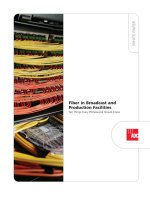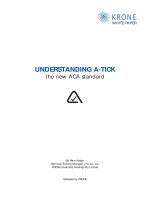Tài liệu Reduced Bend Radius Fiber into the Network docx
Bạn đang xem bản rút gọn của tài liệu. Xem và tải ngay bản đầy đủ của tài liệu tại đây (259.02 KB, 8 trang )
WHITE PAPER
Effective Integration of
Reduced Bend Radius
Fiber into the Network
Introduction
Bending of singlemode fiber has everyone talking these days. The idea
that you can bend a fiber around a pencil without a dramatic increase in
attenuation is a concept that has everyone considering new fiber applications
and design possibilities.
Today, industry standards for traditional single mode fiber typically specify a
minimum bend radius of ten times the outside diameter of the jacketed cable
or 1.5" (38 mm), whichever is greater. This new breed of flexible singlemode
optical fiber has the potential to significantly reduce these minimum bend
radius requirements to values as low as 0.6" (15 mm), depending on the
cable configuration, without increasing attenuation.
There are many names for optical fiber that can endure a tighter bend
radius—“bend insensitive,” “bend resistant” and “bend optimized” are
several that come to mind. However, some of these terms can be somewhat
misleading. Designers and installers may believe reduced bend radius optical
fiber is impervious to all of the forces that can increase attenuation and
cause failure on an optical fiber link. Staff and contract technicians can make
false assumptions on its durability and performance capabilities as well. Such
beliefs can have a serious impact on network performance.
For purposes of accuracy, ADC uses the term “reduced bend radius,” because
this title best describes what the product actually delivers. This paper will
discuss the proper usage for this product and the considerations that must
be kept in mind when deploying it.
Effective Integration of
Reduced Bend Radius Fiber
into the Network
Effective Integration of Reduced Bend Radius Fiber into the Network
Page 3
What is Reduced Bend Radius
Optical Fiber?
As mentioned above, reduced bend radius fiber is
able to withstand tighter bends within frames, panels
and pathways. To understand how this is achieved, it
is important to understand that all fiber types rely on
principles of Total Internal Reflection, which allows a
light signal to travel from one end of the fiber to another
(see Figure 1). By improving the bend radius of optical
fiber, light entering the core is effectively reflected by the
cladding back into the core. Instead of using a matched
clad profile, some constructions of reduced bend radius
optical fiber use a depressed clad profile with a lower
index of refraction than the core, causing light to stay
within this core.
To achieve tighter bend radii, some constructions change
the Mode Field Diameter (MFD)--the area across the core
of the fiber that fills with light. Typical MFD for standard
singlemode optical fiber is about 10.4µm; reduced bend
radius optical fiber may exhibit MFD of between 8.9µm
and 10.3µm
Regardless of the type of construction, all reduced bend
radius fiber products do one thing very well—they can
perform under a tighter bend radius where macrobends
occur. Examples include a CO application, where fiber
exits from a panel into a vertical cable route; or in an
FTTX deployment, within the confines of an optical
network terminal (ONT).
The fiber’s performance is definitely impressive. For
example, in ADC tests a standard singlemode optical
fiber with one turn around a 1.26" (32 mm) diameter
mandrel shows induced attenuation of less than 0.50 dB
at 1550 nm. This same test on a reduced bend radius
singlemode 1550 nm optical fiber shows less than 0.02
dB of attenuation.
In general, reduced bend radius optical fiber is designed
to perform with low loss across the spectrum of
wavelengths, from 1285 nm to 1650 nm, using all the
channels available on those wavelengths to maximize
bandwidth. Current designs include low water peak
or zero water peak so that high attenuation is avoided
at 1383 nm. Many reduced bend radius optical fiber
products meet ITU-T Recommendation G.657, meaning
they work well at 1550 nm for long distance and voice
applications and at 1625 nm for video applications.
Does it Improve Performance?
Despite the improved bend radius, the reality of this fiber
is that bend radius protection is still a concern – just not
to the extent of regular fiber. There is still a mechanical
limit on how tightly any optical fiber
can be routed before the structural
integrity of the glass is violated.
The assumptions about improved
performance are not accurate either,
at least beyond the exceptional bend
radius performance. In reality, the
performance of reduced bend radius
optical fiber—or any optical fiber—
depends upon many factors, not just
bend radius properties.
By itself, reduced bend radius optical
fiber does not offer improvements in
attenuation. True, it bends more tightly without causing
additional attenuation. Yet laid out on a long, straight
run next to a standard optical fiber, there is no difference
in performance that can be attributed to the cables’
construction. It is inaccurate to believe that reduced bend
radius optical fiber is the end-all solution when, in fact,
there are many other factors that determine optical fiber
link performance.
Durability
Reduced bend radius optical fiber offers the same crush
resistance and tensile strength as the same cable with
standard singlemode fiber. As with standard optical fiber,
excessive weight will crush reduced bend radius optical
fiber and excessive pulling tension will damage the cable,
both of which affect attenuation.
n
1
n
2
Refracted
Reflected
Cladding
Core
Ø
Figure 1
Principle of Total Internal Reflection for Optical Fibers
Fiber cladding has a lower Index of Refraction (IOR) than the core,
causing light to stay within the core. Depression of the cladding
profile promotes Total Internal Reflection
Effective Integration of Reduced Bend Radius Fiber into the Network
Page 4
Connector pull-off resistance
Cable assemblies and connectors must meet Telcordia
®
(GR326) requirements for strength of the fiber
termination connector. Reduced bend radius optical
fiber does not improve connector pull-off resistance.
Connectors that are easily loosened or disconnected
increase attenuation and cause failures.
Connector performance
When it comes to connector performance, endface
characteristics determines loss from the connector.
Reduced bend radius optical fiber does not impact
insertion loss from connectors, making termination
and quality of connectors an important consideration
in link performance.
Bend Radius Protection – Just
One Component of Proper Cable
Management
When it comes to an optical fiber network, success may
be measured in one or many ways—maximum system
uptime, minimum operational and material costs, no lost
revenue due to outages. Achieving these goals requires
a complete cable management system that includes
cable routing paths, cable and connector access, physical
protection and, of course, bend radius protection.
Bend radius protection
Reduced bend radius optical fiber and patch cords that
protect against macrobends are a good start—but only
a start. First, there is a limit on the bend radius; it is
smaller, but it still exists. Second, reduced bend radius
optical fiber is still subject to microbends, which can
permanently damage cable. Proper slack storage is still
required to ensure optical fiber and patch cords neither
exceed bend radius limits nor encounter sharp edges on
frames and throughout pathways.
Cable routing paths
It is essential to be proactive when it comes to cable
handling. Vague routing paths create congestion that
reduces density, confuses the next technician and strands
capacity with haphazard use of precious space. Clear,
intuitive cable routing paths are essential for management
of fibers in cabinets, racks, raceways and panels.
Connector and cable access
Front and rear connector access is essential for service
turn-up, rearrangements and troubleshooting. All
connectors need to be accessible without disturbing
adjacent fibers and all connections must be easily
identified to prevent pulling the wrong termination.
There is a physical limit to density. When connectors
cannot be properly removed or seated, service can be
affected. When a configuration is so dense, chassis port
can become inaccessible and are not fully utilized.
Physical protection
Once optical fibers are installed, they should be protected
throughout the network from accidental damage by
technicians and equipment. Fibers routed between pieces
of equipment without proper protection are susceptible
to damage, which can critically impact network reliability.
Robust cable management ensures that every fiber is well-
protected and designed to withstand daily wear and tear.
Proper Applications for Reduced
Bend Radius Optical Fiber
Singlemode reduced bend radius optical fiber offers
benefits for applications that including the central office,
FTTX deployments, the data center and OEM solutions.
Singlemode reduced bend radius optical fiber is best
suited for environments where little or no bend radius
protection is available. It is also ideal for applications
where space is an issue. Specific applications that make
sense for this type of fiber are described below:
Space is tight
For drop cable or termination of pigtails in multiple
dwelling unit (MDU) and optical network terminal (ONT)
boxes for FTTX deployments—where there is no space
and often no cable management—reduced bend radius
optical fiber offers less chance of increased attenuation
during field installation and maintenance.
No fiber management is available
The front of frames and routers—where moves/adds/
changes occur—is ideal for use of reduced bend radius
patch cords and multifiber breakout assemblies. Many
OEM active components do not have bend radius limiters
or protection on the front of the equipment.
Effective Integration of Reduced Bend Radius Fiber into the Network
Page 5
Space is at a premium
Patch cords and multifiber breakout assemblies that can
bend more tightly enable increasing density of active
equipment in racks and cabinets without sacrificing
access. For manufacturers of active equipment, reduced
bend radius optical fiber can help reduce size of
electronics, improving density and airflow. However, in
these applications, even more consideration must be paid
to the elements of proper cable management.
Tighter bend radius also offers OEMs the chance to
increase the functionality of active equipment by utilizing
less chassis space.
Of course, a key advantage of reduced bend radius
optical fiber is use in high bandwidth applications.
For standard optical fiber, the 1625 nm to 1550 nm
wavelengths are the first to go when the cable is
wrapped around a mandrel. Preserving these wavelengths
around tighter bends offers benefits for OEMs seeking
to improve functionality of network equipment or
network managers looking for the efficiency of having all
wavelengths available on a given optical link.
Conclusion
Singlemode reduced bend radius optical fiber has
generated quite a buzz, and is a great step forward in
optical fiber construction. It makes the much-handled
patch cords and multifiber assemblies less susceptible to
macrobends that affect attenuation and limit bandwidth
of optical fiber links.
It is crucial for the health and performance of your
network to be aware that reduced bend radius fiber does
not, in any case, mean that the fundamentals of proper
fiber management are to be ignored. In fact, as this fiber
is used in higher density applications, factors such as
connector access and cable routing paths become even
more crucial. Reduced bend radius optical fiber is just one
aspect of a complete strategy for efficient, future-proofed
network management.









